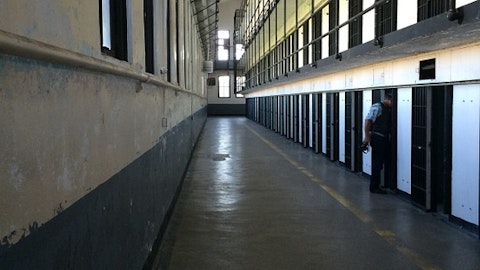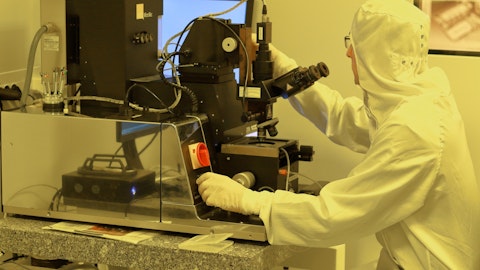Craig Ellis: Yes. Thanks for taking the question. What I wanted to do, Luis, is just try a shorter term question and then a longer term question. Around the shorter term side, and this one goes back to some of the comments around downstream utilization and where the business is over the next couple of quarters. But assuming utilization is near current levels or maybe drifts up a little bit in a seasonally stronger second half, how do we think about the gives and takes with normal seasonality in the fourth quarter. Typically, the business would be down much more in the systems side than recurring. But typically, that would be off much more significantly inflated levels. So, can you just help us understand how we should think about some of the seasonal dynamics given the unusual year we have thus far?
Luis Muller: Sure, Craig. As you know, well, this industry has both seasonality and cyclicality with seasonality essentially being the – obviously, the 12-month cycle, right, or the 12-month pattern of the wave and the cyclicality being more of a multiyear, I think you call it as a 4-year, give or take 4-year period. When you overlay the two, you may have one obscuring the other. And I think this is a classical year where you are not going to see in as much the seasonality because we are coming off of a trough where we are at the moment. And all the indications is the market starts to improve in the second half of the year and going into a 2025 recovery. In other words, I don’t think you will see your typical seasonality this year.
It’s just not possible when the cycle is dominating what’s happening in the market. It’s very, very likely and I have seen this happen in prior cycles that you exit the year with a strong order momentum going into the next year when otherwise, you should have seen a pretty weak seasonal period in the fourth quarter. And I think that’s going to be the case again this year. Again, I think cyclicality just overshadows seasonality in this environment.
Craig Ellis: That’s really helpful, Luis. And the second question is related to the target model. So, great to see the business raise the gross margin target by 100 basis points to 50%. You guys have had really strong trailing 2-year to 3-year gross margin execution. So, I can see that. My question was more on the line about that revenue. So, from third quarter levels, we annualized a little north of $400 million and so the target is about 2.5x that. And what I wanted to do is give you the opportunity just to talk about the path that you see for the business to go from annualizing at $400 million back to $1 billion? What are some of the things that are going to be the biggest drivers to that growth, whether it’s on the product side or other things that you and the team are working on that will in a much better demand environment, deliver revenues that are out on your target? Thank you.
Luis Muller: I can talk a little bit about the business dynamic heading to that target, Craig. You can’t necessarily pick the trough of the cycle and then try to explain to that $1 billion target. I think you got to look at more of a through cycle, what is the number at the through cycle level, which tends to be somewhere in the $750 million to low-$800 million, what we typically call a normalized or through-cycle revenue level. How do we grow from there, it’s a combination of design wins on the tester side, which we have been scoring by the way, they just don’t translate into volume at the moment. Optimization and wins on the interface side, which is holding pretty well considering the overall low utilization levels in the industry right now, and an expansion of our inspection and metrology business, right.
Those are the primary focus areas. We are – from a market perspective, we are putting a tremendous amount of effort right now to align more to computing applications. We are a very strong believer on the long prospect – long-term prospects for computing. And I don’t mean necessarily just AI data centers, which are low volume. But I think the wave that comes after that, which is computing at the edge, or AI at the edge, if you will. When those get proliferated into cell phones, into cars with higher level of autonomous driving, when you get more robotic systems and automated manufacturing tools. So basically, AI at the edge should be a significant driver of sensors, communication and ultimately computing processing power. So, one of the key areas of investments for us today is on the thermal subsystems and the implementation of those thermal systems into our equipment to enable capturing of share and supplying – supporting our customers when they start proliferating AI at the edge, so to speak, or more computing processing at consumer level products.
So, those are the primary drivers as we see our target to get up to $1 billion.
Craig Ellis: Great. Thank you.
Operator: Our next question comes from the line of Toshiya Hari with Goldman Sachs.
Toshiya Hari: Hi. Thank you so much for taking the question. Luis, you have given quite a bit of color in terms of what you are seeing from an end demand or end market perspective. I was hoping you could share what you are seeing by device type. I know you have exposure to various device types, but any specific areas of relative strength or relative weakness MCUs, analog, RF, etcetera, that would be helpful. Thank you.
Luis Muller: Okay. Toshiya, I don’t have the data exactly in front of me by device type. I can qualitatively tell you the analog – the general analog semiconductor space is weakest at the moment. No significant strength also in microcontrollers. We see as some interesting dynamics in the processor space. As I have said earlier, more of it is on the high ASP low quantities, but that is said to be migrating more to servers and therefore, a little bit better improvement in the quantity side. We have also seen recently some improvement on FIC manufacturing and demand for test in handling equipment. And I would say battery management systems, which is – it’s part of analog at the end of the day, but BMS is becoming a bit of a mixed signal type device today.
Battery management systems are weak, but maybe coming to a threshold of demand again. So hopefully, that gives you a bit of color from a device segment size. And we don’t participate today in memory, right. So, we didn’t comment on memory, but Cohu today does not participate in the memory space.





